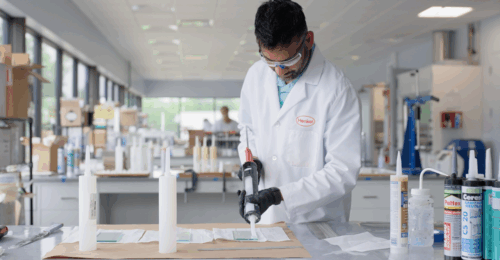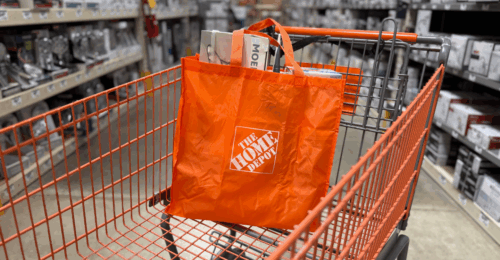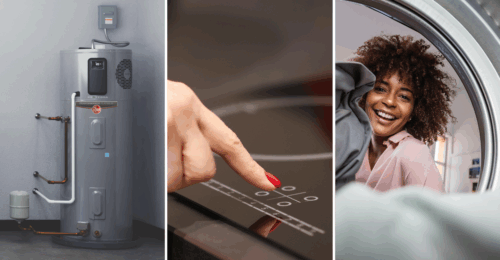Within The Home Depot, there is a large contingency of eco-conscious associates. They call themselves the Sustainability Squad, and they are living proof that Eco Actions make a difference. They are living a DIY sustainability lifestyle. Each month, we sit down with members of the Sustainability Squad to learn more about their inspiration and motivation.
This month, we sat down with Manager of Secondary Market Programs Lindsey Tornello. Now in her second decade with The Home Depot, Lindsey talked to us about how materials are recycled and given a second life within Home Depot product packaging.
 EA: Lindsey, thank you again so much for being with us today. How are you doing?
EA: Lindsey, thank you again so much for being with us today. How are you doing?
LT: I’m doing awesome, thank you.
EA: We’re so glad. So, let’s start at the beginning. How did you come to The Home Depot?
LT: I came to The Home Depot straight out of college, actually. I got a degree in early childhood education, and it ended up just not being my thing. I ended up staying with Home Depot, and it has been 23 years now. I moved my way through the stores, starting as a garden associate, and then came here a little over four years ago.
EA: What attracted you to your current position?
LT: When we started to open up our appliance delivery centers, they came to me and said, “We’re looking into starting our own appliance delivery program and need help setting up a recycling capability for haul-away appliances, including refrigerant due to regulatory requirements. Would you be interested?” And my response was, “Absolutely!”
EA: So, what does your day-to-day work look like in your position? What gets you excited?
LT: I love being able to look back and give back to the field. That has always been a big thing for me having spent more than 18 years of my career there. I always wanted to do something at our Store Support Center where I could support field associates and give them that love that I’ve received from so many people when I worked in the stores. This position really allows me to do that. We have associates in the field who are passionate about recycling and sustainability within the company – being able to drive those programs, getting great ideas from them, seeing their passion for the different materials that Home Depot takes back and what can be done with them.
EA: Absolutely. Now, were you interested in sustainability before you began, or did it develop as you progressed with your job?
LT: I think I always had an interest in it. I wouldn’t necessarily say it was a passion originally because you just know you need to do the right thing, right? Especially after I had my son, I really started to see the impacts of the things that we do and started thinking more about the future. But I don’t think it was until I really came in and saw the whole process that I realized how exciting it is. A lot of focus is on the front side, on the selling side, and you don’t really think about where your waste goes after it’s put on a truck and sent back to a Reverse Logistics Center. I think seeing the amount of materials that we have to deal with, the materials that are returned within the company, and then being able to do something with them brought the passion. It was always an interest, but the passion definitely came later.
EA: What materials do you recycle at Home Depot?
LT: We recycle metal, hard plastics, soft plastics, Styrofoam and refrigerants, commonly known as CFCs, from returned appliances.
EA: How do these materials make it back into the products and packaging that you guys sell?
LT: We partner with a company called Radius, formerly known as Schnitzer. They’re a national recycling partner of ours, and we’re constantly looking at the recycling market, who’s making the newest, coolest products and what we can do with all of it. Take the Styrofoam packaging that comes with appliances. When we install appliances for consumers, we recycle all that Styrofoam at our Market Delivery Operations, or MDOs, across multiple locations within the company. The recycled Styrofoam is made into moldings that are sold in the stores. It’s a circular item and is also made into drainage systems, like French drains, that we sell.
EA: That’s impressive. What percentage of your locations does that cover?
LT: It’s 100% of our MDOs that recycle Styrofoam, and all appliance delivery centers for Home Depot recycle Styrofoam.
EA: What plans does your department have for future efforts?
LT: Looking at what we’re going to do in the future, we conduct waste audits pretty frequently. Right now, our newest focus is plastic banding within our Distribution Centers. It’s been a constant challenge for Home Depot, thinking about how much lumber banding we deal with. We have just started collecting and recycling that banding, looking at different products within Home Depot that we can turn those into. That would be the newest initiative coming from waste audits within not just stores, but also our supply chain facilities.
EA: Lindsey, so much of your work deals with circularity. Why is fostering a circular economy important to you, and do you feel that The Home Depot is working towards that?
LT: Why is it important? I think it is a tangible representation of our core values to our associates and consumers. It’s something you can hold in your hands that represents doing the right thing, entrepreneurial spirit and so many of our core values. Our associates know they put that plastic wrap into a bin, but they don’t know where it goes. It’s like when you put your recyclables in your trash can outside; you hope that waste management is doing the right thing. But when an associate or consumer can walk into a store and see a box of U.S.-made trash bags on the shelf, clearly stating that a portion of it came from materials recycled out of our Distribution Centers, it gives life and meaning to the decisions they make. Home Depot is making amazing strides with this, partnerships, our environmental team and our merchants to really drive these materials into new products. It takes a lot of different teams to make these things come together, and everyone is excited about it.






